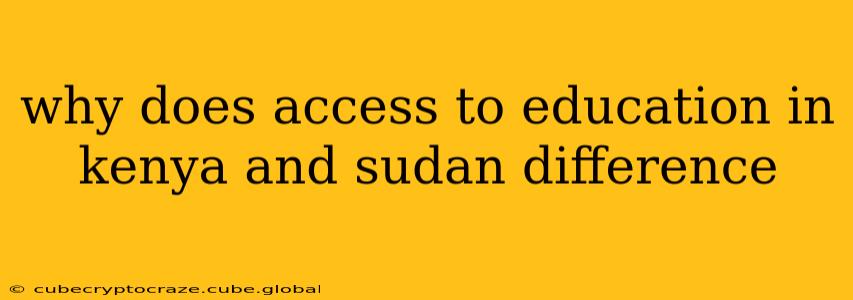Access to education in Kenya and Sudan, while both facing significant challenges, differs considerably due to a complex interplay of factors. Understanding these discrepancies requires examining political stability, economic disparities, geographical limitations, and cultural nuances. While both countries have made strides in improving educational access, considerable gaps remain.
What are the main challenges to education in Kenya?
Kenya, despite its relatively higher economic standing compared to Sudan, still faces considerable obstacles in providing equitable access to quality education. These challenges include:
- High Poverty Rates: Poverty significantly restricts access, particularly in rural areas where many children are forced into labor rather than attending school. The cost of school fees, uniforms, and books remains a barrier for many families.
- Unequal Resource Distribution: Resources, including qualified teachers and infrastructure, are often concentrated in urban areas, leaving rural schools under-resourced and struggling to provide adequate education.
- Gender Inequality: Girls often face greater barriers to education than boys, due to cultural norms, early marriage, and pregnancy.
- Infrastructure Deficiencies: Lack of adequate classrooms, sanitation facilities, and learning materials in many schools hinders effective teaching and learning.
- Teacher Shortages and Training: A shortage of qualified teachers, particularly in remote areas, coupled with inadequate teacher training, impacts the quality of education provided.
What are the main challenges to education in Sudan?
Sudan's education system faces even more significant hurdles than Kenya's, stemming primarily from:
- Prolonged Conflict and Political Instability: Decades of civil war and political instability have severely disrupted the education system, causing widespread destruction of schools and displacement of populations. This has led to significant learning losses and hampered educational development.
- Extreme Poverty and Inequality: Widespread poverty and extreme inequality exacerbate the challenges, limiting access to education for a large segment of the population.
- Geographical Barriers: Sudan's vast and geographically diverse landscape makes it difficult to provide education to all regions, especially remote and underserved communities.
- Limited Resources: The country suffers from a chronic shortage of resources, including funding, qualified teachers, and learning materials.
- Cultural and Religious Barriers: Traditional beliefs and practices in some communities limit girls' access to education, particularly in rural areas.
How do the different political systems affect education?
Kenya, while not without its political challenges, has experienced greater political stability than Sudan in recent decades. This relative stability has allowed for more consistent policy development and investment in the education sector. Sudan's prolonged conflict and political instability have significantly hampered progress in education. The frequent changes in government and the lack of consistent policy have led to disruptions in education delivery and planning.
What is the role of funding in education access?
The level of funding allocated to education is a crucial factor. While both countries face funding constraints, Kenya generally enjoys a higher level of investment in its education system than Sudan. This difference in funding directly translates into differences in infrastructure development, teacher salaries, and the provision of educational materials. The inadequate funding in Sudan further restricts access to education, especially for marginalized and vulnerable populations.
What initiatives are being taken to improve education access in both countries?
Both Kenya and Sudan are implementing various initiatives to improve education access, though the scale and effectiveness vary significantly. Kenya has implemented free primary education, while Sudan faces greater difficulties in implementing such large-scale initiatives due to its ongoing political and economic instability.
In conclusion, the differences in access to education between Kenya and Sudan are rooted in a complex interplay of political stability, economic development, geographical factors, and cultural norms. While Kenya faces considerable challenges, particularly in ensuring equitable access to quality education, Sudan grapples with far more significant obstacles stemming from prolonged conflict and extreme poverty. Addressing these complex issues requires sustained and comprehensive strategies tailored to the specific context of each country.
